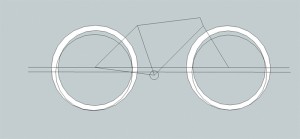
By Tom Jow
Actually, the original 29ers were multi-geared hard tails. It seemed like, however, that the single-speed riders were among the first to really take advantage of the larger wheels. Riding a single-speed is all about carrying momentum, and that is one of the main benefits of the 29 inch wheel. Now, 15 years into their current form, the big wheel is gaining favor among all categories of riders including all-mountain and elite cross-country racers. What is the history of these trend setting bikes and what makes them different?
It was in the mid 1990’s when the current trend of 29 inch wheel bikes were developing, and it was multi-geared, cross-country hard tails were the first designed. While the originator of this trend in mountain bikes may be in dispute, it is clear that the first major bicycle manufacturer to take on this new category was the Gary Fisher brand. Within a few years, Fisher also had a cross-country full suspension on the market. While it seemed like the 29er had many advantages, selling this new platform to the public, however, was not so easy. Nobody outside of bike shops had ever heard of these new bikes. They rode well but didn’t feel like the 26 inch bikes we were accustomed to. Critical components such as suspension forks, tires and wheels were being made by only a few companies. Nor were these components particularly light either. The big question was how would early adopters get replacement parts if the platform failed. It seemed that 29ers could end up being a flash in the pan.
How did these big wheel bikes become popular with the masses? It took two unique types of riders to see the benefits of the large wheels, ultra-endurance racers and single speed riders. What did they see in the 29er over the 26er? The endurance racers found that the 29ers were more efficient. It was saving them energy. The single speed riders discovered they were able to carry more momentum over both terrain and obstacles. There are other benefits as well. The larger wheels also create more stability and increased traction.

How does an increase in wheel size accomplish all these things? The reasons are many, in fact, where to begin? First, the larger wheel rolls over obstacles in the trail easier. When the larger wheel approaches an obstacle in the trail, a rock for example, it is taller, which lowers the angle to roll over it by approximately 1 degree. It doesn’t sound like much, but on the trail it is a noticeable difference. For this reason, the wheels roll over things easier and the rider will more easily retain his/her momentum. It also requires less energy to get over obstacles.
Another benefit to using twenty nine inch wheels is increased stability. The centrifugal force of the spinning wheels helps to keep them on line in rough terrain and once rolling, they want to keep rolling..A another factor of stability and handling is in the frame design. One dimension which determines bicycle handling and stability is the bottom bracket height. A lower bottom bracket provides for a lower center of gravity. For this article, we’ll compare another dimension, bottom bracket drop. This is the distance the bottom bracket is below the level of the wheel hubs. In the drawing below, you can see that with an equal bottom bracket height, the bottom bracket drop will be approximately 1 ½” (the difference in radius between a 29 inch and 26 inch wheel) greater for the 29er. Therefore, while a 26inch frame and a 29 inch frame may have the same bottom bracket height, the center of gravity is effectively lower because the bigger wheel bike has the bottom bracket deeper between the wheels.
There’s more of everything where the wheels are concerned with a 29er, and that includes traction. The bigger wheels also have a larger contact patch compared to 26 inch bikes. Not only is overall traction increased, but the larger contact area increases both traction and stability in soft soils and especially sand. In addition, this increased contact patch allows the tire to “bridge” across holes and multiple obstacles.
Aren’t there any drawbacks to riding a 29er? Well, yes, but many have been overcome through improvements in design and availability of components. For example, for many years there was only one major brand of frame, fork and wheel. Now, most major brands have one somewhere in the line if not more. Nearly all fork manufacturers have compatible products. Wheels and tires were heavy and were the main contributor to a seemingly sluggish ride. Now there are multiple offerings from many brands from ultralight cross-country to heavy-duty all mountain.
After all these years the 29er has come into its own and is now a truly viable option to 26 inch wheel bikes. Nearly every brand has one or two in their line. Replacement and upgrade parts are widely available. What was needed was some people to ride the bikes and get feedback to the designers. An “evolution of a species” so to speak. The modern 29er is now available for every type of rider, retro throwback, single speed rigid to ultra-light carbon full-suspension cross-country to long travel all-mountain style. There is at least one brand developing a 29er downhill bike. Curious? Visit your favorite bike shop and try one out. Skeptical? Just look to the cross-country racing results. If 29ers are good enough for World Cup winners and National Champions, they are good enough for us.

